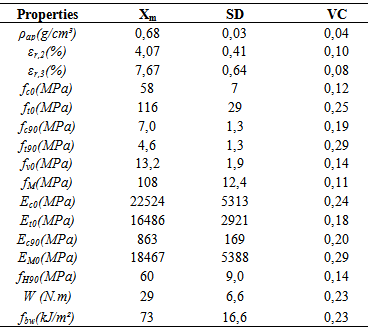-
Paper Information
- Paper Submission
-
Journal Information
- About This Journal
- Editorial Board
- Current Issue
- Archive
- Author Guidelines
- Contact Us
Journal of Civil Engineering Research
p-ISSN: 2163-2316 e-ISSN: 2163-2340
2013; 3(3): 98-103
doi:10.5923/j.jce.20130303.02
Characterization of Tropical Wood Species for Use in Civil Constructions
André Luis Christoforo1, Karen Anéris Blecha2, André Luis Cerávolo de Carvalho1, Luiz Fernando Silva Rezende1, Francisco Antonio Rocco Lahr2
1Department of Mechanical Engineering, Federal University of São João del-Rei (UFSJ), São João del-Rei, 36307-352, Brazil
2Department ofStructural Engineering, Engineering Schoolof SãoCarlos (EESC/USP), São Carlos, 13566-590, Brazil
Correspondence to: André Luis Christoforo, Department of Mechanical Engineering, Federal University of São João del-Rei (UFSJ), São João del-Rei, 36307-352, Brazil.
| Email: |  |
Copyright © 2012 Scientific & Academic Publishing. All Rights Reserved.
The wood is one of the most applicable materials in industrial activities due to its availability allied to its satisfactory mechanical properties, presenting a good strength/density relation. Its versatility is fundamental for the large expansion of its use on structure building. The exploration, initially selective, turned to be selective and also predatory, what lead to a shortage, raising systematically the prices until the moment where it was not anymore probable to use it on the quantities registered until then. The solution was to define species, between more than 5.000 varieties in AmazonicaTropical Forest, which could substitute the 100 commercially used ones. However, due to technical limitations, these species cannot be completely characterized, what leads to a misusing of timber, once its behaviour is not known completely when it is under mechanical stresses. This research presents some results of the characterization of the following timber species: Canelão, Envira Branca, Guarajá, Quaruba Rosinha and Breu Vermelho. These species are found close to Sinop (Mato Grosso - Brazil), and the results obtained reveal clearly the potential of each species under mechanical stresses, showing that some of them can be good substitutes to the commonly wood speciesused.
Keywords: Wood, Characterization, Tropical Species
Cite this paper: André Luis Christoforo, Karen Anéris Blecha, André Luis Cerávolo de Carvalho, Luiz Fernando Silva Rezende, Francisco Antonio Rocco Lahr, Characterization of Tropical Wood Species for Use in Civil Constructions, Journal of Civil Engineering Research, Vol. 3 No. 3, 2013, pp. 98-103. doi: 10.5923/j.jce.20130303.02.
Article Outline
1. Introduction
- The wood, one of the most utilized materials on the human history, is directly related to usual human activities like living, overcoming natural obstacles, transportation and agriculture, among others.Its versatility was always fundamental for the human needs and its wide availability was an important factor for a large expansion on its use in structure building, e.g. bridges, silos and roofs.The application of timber in structural tasks is due to the highly satisfactory properties of some species like the Aroeira do Sertão (Astroniumurundeuva), CabreúvaVerme- lha (Myroxylumbalsamum), Faveiro (Pterodonpubences), Pau Marfim (Balforodendronriedelianum), Peroba Rosa (Aspidospermapolyneuron) and Pinho do Pará (Araucaria angustifolia). However, the indiscriminate exploration of these species since 1880 originated the first shortage warnings[1].According to Souza[1] the exploration initially selective, and then selective and predatory, happened due to the lack of information about most of wood species. This lead to the exploration of the species which were alreadycharacterized, reducing the receptivity of the market to new and no trustable species.The imminent shortage was responsible for a systematic rising in the prices, until the point where it was not anymore probable to use it on the quantities registered until now.It is now a new moment to the Brazil wood sector, when it is necessary to define which species can commercially substitute the traditionally used species on structural constructions[2].It is know that the Tropical Brazilian Forests occupy approximately 2.600.000 square kilometers on the north and central-west regions of Brazil. According to Gonçalves et al[3], it is estimated that there are more than 5.000 species of trees in Amazonian Tropical Forest, while only about 100 are used commercially and not more than 12 are exported to other countries.In 1982, while there was a plan of the creation of trading posts for timber, with the objective of increasing the number of exported species, the National Institute of Forest Development[4] registered that: less than 100 species were employed on the timber industry on the Amazonian Region; national consumers had about 40 preferred species of timber; international consumers had few more than 10 preferred species of timber. This situation lead to a decision point on the research institutes related to timber.Properties of species originated on the Amazonian Tropical Forest, already used for structural purposes, but without complete knowledge of their behavior under mechanical stresses are presented on[5-12].However, due to technical limitations, it has not been possible to characterize completely the referred species, what leads to a misuse of the timber, without the real knowledge of their behavior under mechanical stresses.It is important to state that there are still indicatives that the Amazon Tropical Forest is suffering of selective and predatory exploration. The consequences of this reflect on the almost 20% of the original area already devastated in an irreversible way, according to the National Institute of Space Research (INPE)[13], entity related to the Ministry of Science and Technology of Brazil. Thus, it is evident that an attitude needs to be taken to decrease the deforestation rate of the tropical forest, especially:−Stimulus for the application of procedures to handle forests in an auto-sufficient way;−Spreading of the available information about alternative species characterized by research institutes;−Maintenance and development of programs to characterize native species;−Awareness of the market of timber about the importance of substitution of species.The present research is inserted in the present scenario, looking for characterize mechanically and physically the Brazilian forest timbers and, in particular, the ones located in Sinop city (MatoGrosso – Brazil), contributing for its rational distribution on the consumer market. It was evaluated too the estimative of the strength properties of the wood species with known the density.
2. Material and Methods
- In order to proceed with this work, were used five species of timber originated from certified areas of tropical forest, provided by the Syndicate of Timber Industries of Mato Grosso (SINDUSMAD) of Sinop, being these: Canelão (Ocoteasp), Envira Branca (Xylopiasp), Guajará (Micropholisvenulosai), Quaruba Rosinha (Vochysiasp) and BreuVermelho (Protiumsp).These species were in pieces with nominal dimensions of 6cm×12cm×300cm. These passed by a drying process posteriorly, to reach a moisture content of 12%, the recommended percentage by ABNT NBR 7190[14]. From these pieces, were extracted the samples for characterization, standardized by the referred standard, with small dimensions and no defects. It is important to state that in future works these species will be characterized considering the pieces with structural dimensions, making possible to analyse differences between them[15-20].The tests to characterize the physical and mechanical properties were performed following the recommendations of the B Annex of the standard ABNT NRB 7190[14]. Were investigated the following properties:−Strength of parallel compression to the grain (fc0);−Modulus of elasticity in parallel compression to the grain (Ec0);−Modulus of elasticity in normal compression to the grain (Ec90);−Strength of parallel tensile stress to the grain (ft0);−Longitudinal modulus of elasticity in parallel tensile stress to the grain (Et0);−Strength modulus in bending (fM);−Bending modulus of elesticity (EM0);−Strength of normal compression to the grain (fc90);−Strength of parallel shear stress to the grain (fv0);−Strength of normal tensile stress to the grain (ft90);−Strength ofcracking parallel to the grain (fs0);−Bulk density (ρap);−Retraction on radial (εr,2) and tangential directions (εr,3) to the grain;−Parallel (fH0) and normal hardness to the grain (fH90);−Strength tensile (W);−Strength impact in bending (fbw).For each one of the18 properties analysed, there were 12 samples[12], what resulted in 216 tests per species analysed.
3. Results and Conclusions
- Tables from 1 to 5 present the average results (Xm), standard deviations (SD), and variation coefficients (VC) of each one of the properties analysed per species.
|
|
|
|
|
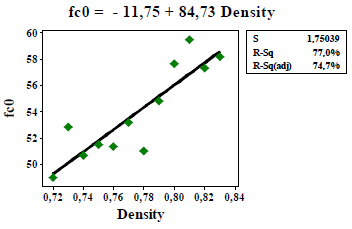 | Figure 1. Linear regression between density and strength compression parallel to the grain of Canelão wood species |
 | Figure 2. Linear regression between density andstrengthtensile parallel to the grain of Canelão wood species |
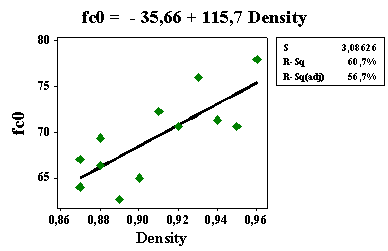 | Figure 3. Linear regression between density and strength compression parallel to the grain of Envira Branca wood species |
 | Figure 4. Linear regression between density andstrengthtensile parallel to the grain of Envira Branca wood species |
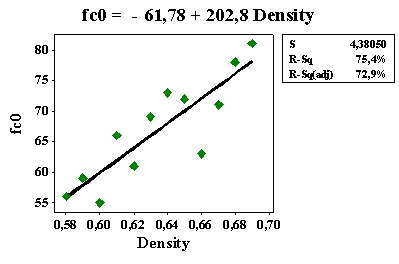 | Figure 5. Linear regression between density and strength compression parallel to the grain of Quaruba Rosina wood species |
 | Figure 6. Linear regression between density and strength tensile parallel to the grain of Quaruba Rosinha wood species |
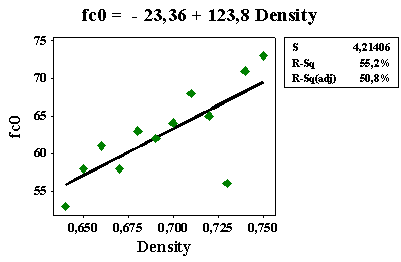 | Figure 7. Linear regression between density and strength compression parallel to the grain of Guajará wood species |
 | Figure 8. Linear regression between density and strength tensile parallel to the grain of Guajará wood species |
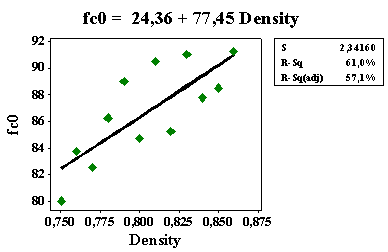 | Figure 9. Linear regression between density and strength compression parallel to the grain of Breu Vermelho wood species |
 | Figure 10. Linear regression between density and strength tensile parallel to the grain of Breu Vermelho wood species |
4. Conclusions
- Considering the resultsobtained from regression between density andstrengthtensile parallel to the grain ofGuajará wood species of the physical and mechanical properties of the five species analysed, it is possible to conclude that:−Canelão, Guajará and BreuVermelho wood species can be compared to OiticicaAmarela and AngelimPedra, two species usually employed in Brazilian structures;−Quaruba Rosinhawood species can be compared to Quarubarana and LouroPreto, two species usually employed in Brazilian structures;−Envira Branca wood species can be compared to Canafístula e Guarucaia, also species commonly present in Brazilian structural constructions.According with the results, the timber species originated from North of MatoGrosso (Brazil) that were investigated on this work, can be employed in structural projects substituting with the same or superior performance the species commonly used.The results of the linear regression between density and tensile and compression strength parallel to the grain indicate that is possible determine the strength properties with knowledge the of de density of the wood species investigated.
ACKNOWLEDGEMENTS
- The authors are grateful to the Syndicate of Timber Industries of North MatoGrosso (SINDUSMAD) for providing the wood species required for this research.
 Abstract
Abstract Reference
Reference Full-Text PDF
Full-Text PDF Full-text HTML
Full-text HTML


